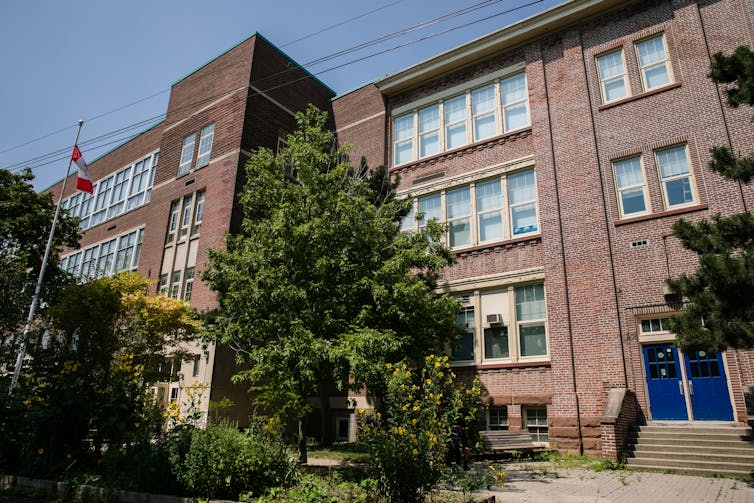, PhD Candidate in Developmental Psychology and Education,┬Ā;╠², Professor, Department of Applied Psychology and Human Development,┬Ā;╠², Professor Emeritus, School of Communication Sciences and Disorders,┬Ā, and┬Ā, PhD Student in Developmental Psychology,┬Ā.
The Ontario Human Rights CommissionŌĆÖs , published last February, called for changes in the provinceŌĆÖs educational system. The commission found shortcomings in how schools support students with special education needs.
We found similar trends in our on the accessibility of French immersion for students with special education needs from low-income communities in Toronto. We interviewed eight mothers with diverse socio-economic status, home language and immigration backgrounds on their experiences with the French immersion program.
According to the Right to Read reportŌĆÖs , children need accessible, effective learning assessments, as well as evidence-based interventions that occur in a timely manner.
These interventions include explicit, systematic programs that focus on , (a larger awareness of language, including an ability to reflect on it) and other skills ).
Research has highlighted difficulties accessing support for students with special education needs . As we also heard in our study, parents of children with students with special education needs from low-income communities in Toronto faced barriers accessing resources for their children.

Marginalized students underrepresented
French immersion programs have become increasingly popular , since students who learn both English and French in school may , easier travel throughout Canada, better access to bilingual jobs as well as potential .
There is a for French immersion in Canada, and the program is often perceived as .
In the , marginalized students are underrepresented in its immersion programs. For example, the report ŌĆö based on registration and census information ŌĆö noted that in grades 7-8:
49 per cent of students identify as white in French immersion and 30 per cent in the board overall;
students without special needs represent 90 per cent of students in French immersion and 78 per cent of students in the board overall;
Students whose family income is $100,000 and over represent 66 per cent of students in French immersion and 47 per cent of students in the board overall;
Children from families who speak English at home represent 63 per cent of French immersion classes and 35 per cent of the board overall.
Reading struggles
Emily (not her real name) is one of the mothers who participated in our study. She has seen the . With her permission, we have shared her story below to illustrate her familyŌĆÖs experience in a French immersion program.
Emily enrolled all of her three children in a French immersion program. EmilyŌĆÖs eldest child excelled in immersion, and continued to study French into university. However, EmilyŌĆÖs two youngest were struggling to read in French. The teachers assured her that her children would catch up in time and there was no need to worry.
Shockingly for Emily, once her middle child reached Grade 3, she was suddenly informed that her child was reading at a kindergarten level.
However, the wait to be assessed was approximately three years ŌĆö meaning this child might be in Grade 6 before they received any formal assessment and intervention support.
At the suggestion of the schoolŌĆÖs administration, Emily agreed to pay $3,500 for an external evaluation. She said about the experience:
ŌĆ£IŌĆÖll never forget it, having that SST (school support team) meeting. IŌĆÖm in front of the psychologist and all these different people and I literally lost control. The head of special education, she said, ŌĆśItŌĆÖs okay.ŌĆÖ IŌĆÖm like, ŌĆśIŌĆÖm not crying because my daughter has a learning disability. IŌĆÖve come to terms with that.ŌĆÖ I said, ŌĆśIŌĆÖm crying because I had to pay $3,500 dollars ŌĆ”ŌĆÖŌĆ” How many kids are falling through the cracks?ŌĆÖ That was very disconcerting for me. I was heartbroken.ŌĆØ

Insufficient special education support
Even after spending an exorbitant amount of money, Emily found out the hard way that there wasnŌĆÖt sufficient special education support in French immersion for her child. She ended up removing her middle child from the immersion program the next year. EmilyŌĆÖs middle child did get the support she needed in the English program.
This is just one example of the stories we heard in our research study on the accessibility of French immersion.
EmilyŌĆÖs question stayed with us throughout our work: How many students are falling through the cracks?
The truth is, we donŌĆÖt really know. Based on the attrition rates in French immersion from the TDSB, it must be high. According to a from the early French immersion cohort where students start in senior kindergarten, approximately 70 per cent of the students have left the program by Grade 9.
Need for early intervention
In our study, one parent was told that her child couldnŌĆÖt be assessed until Grade 3, which contradicts that call for early assessment and intervention.
Parents also said they often feel pressure to pay for expensive tutors, French summer camps and other language immersion opportunities so their children donŌĆÖt fall behind.
They reported spending a lot of time supporting their childrenŌĆÖs studies despite not speaking the language of instruction, and this ends up becoming an emotional and financial burden.
Ensuring changes are implemented equitably
Following the Right to Read inquiry, the Government of Ontario committed to sweeping change such as . We have also seen a huge amount of for teachers. Ensuring that positive change yielded by these approaches are effective in French immersion programs is critical.
We know that individual resilience and community support networks arenŌĆÖt enough to combat systemic barriers.
We still have a long way to go if we want our school system to be an equitable learning opportunity for all students ŌĆö particularly in immersion.![]()
This article is republished from under a Creative Commons license. Read the .

